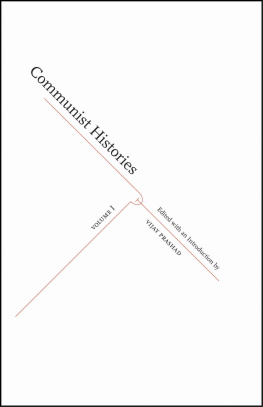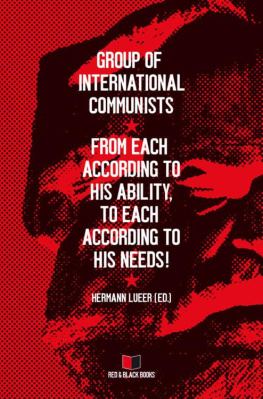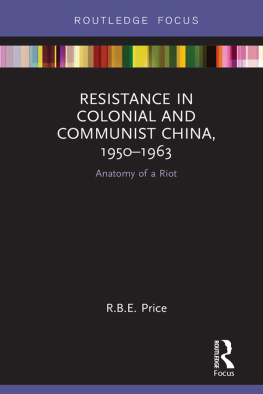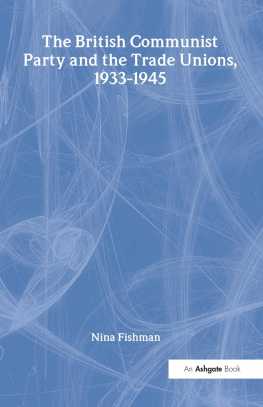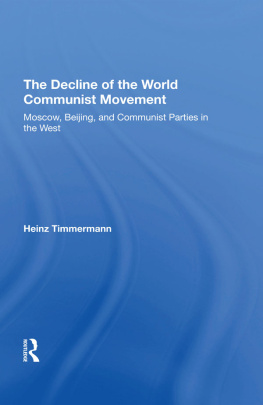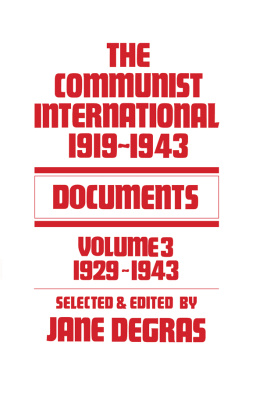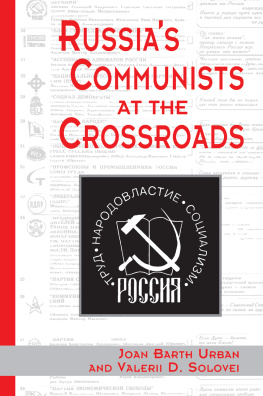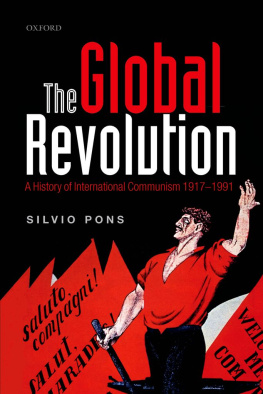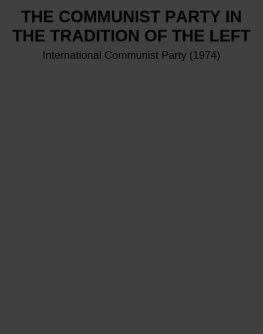Naya Rasta Publishers Pvt. Ltd.
Vijay Prashad
Introduction: Communist Histories
History with the Communists Left Out
As the Berlin Wall and the Soviet Union collapsed between 1989 and 1991, the debate over the past and future of Communism rose to a fever pitch. New archives in the Soviet Union and in Eastern Europe opened up to allow scholars to assess not only the history of these regions, but also of the Communist movement elsewhere. In particular, the Communist International (Comintern) archives possessed material that would shine a light on Communist activities from 1919 to 1943, the period when the Left coalesced into the Communist movement in many parts of the world. A flurry of books on Communism, particularly on these decades of the Comintern, emerged. The tenor of these books was generally unkind to the Communist movement although it is better to have them than no history at all. The general suggestion was that Communists from the United States to Indonesia operated as puppets of the Soviet Union. They had no autonomy from Moscow, and indeed survived largely due to Moscow Gold. Since the Soviet Union had now fallen went the argument it was time for its satellites to all fall into the black hole of history.
In Italy, for example, the new leadership of the Communist Party (PCI) began to reassess its past, particularly the role of Palmiro Togliatti (its leader from 1930 to 1934 and then from 1938 to 1964). Togliatti was not only the pillar of the PCI, but he was also, as Justice Minister, one of the key drafters of the Italian Constitution of 1947.
Corruption scandals dented both the Christian Democrats and the Socialist Party, which opened the door for the PDS to lead an Alliance of Progressives to victory in 1994. This prospect drew Silvio Berlusconi from his boardroom to the streets. He galvanized the Right as the Pole of Liberty, which included the fascist parties. Since they had shielded their history from attack, Berlusconi went after the Left. Left-wingers pretend they have changed, he said in his opening speech, they claim that they are liberal-democrats now, but it is not true, they are the same as before, their mentality, their culture, their deepest beliefs and their behaviour are just the same as before. The attack at the historical role of the Communists was not merely a historiographical debate; it was one that was used to discredit the Left as rooted in Soviet history and therefore anachronistic in the new age. The fascists, on the other hand, did not need to stand to account for their views. Berlusconi rode this attack on the Left to victory. The Left was largely wiped off the face of the Italian political landscape. From coming close to power in 1994, they fell to the lure of moderation. The Democratic Party, now in power, is the remnant of this collapse.
In India, the story much the same took place a decade earlier. From the margins of Indian politics, the Extreme Right began to make its appearance on the main stage. Rechristened as the Bharatiya Janata Party (BJP), the Extreme Right won only two seats in the Indian parliamentary elections of 1984. But this was an aberration. Its leadership mounted their chariots for the Ramjanambhoomi campaign to build a temple to Ram on the site of an old mosque in Ayodhya. The BJP believed that this campaign would consolidate a Hindu vote bank in its favour. By 1996, the BJP would become the largest party in the Indian parliament. It was a spectacular rise. At the same time, the Left rose from thirty-three seats in parliament in 1984 to fifty-two seats in 1996. If this is any indicator of political strength, the Left appeared buoyant. It played a decisive role in the formation of the United Front government in 1996, which kept the BJP out of power for two years. An attack on the Left, therefore, was not idiosyncratic. It was politically essential.
In 1984, economist and journalist Arun Shourie wrote a series of articles in the Illustrated Weekly of India. The series went after the Left for its role in the Freedom Movement. The event that allowed Shourie to condense all his calumnies against the Left was the role of the Communists in the Quit India struggle of 1942. The Communists, Shourie wrote, took their orders from Moscow to support the Great Patriotic War and thereby to ignore the Do or Die cry of the August 9 Quit India agitation. This is the betrayal of the communists. Shourie would later expand these articles into a book Only Fatherland: Communists, Quit India and the Soviet Union (1991). The attack on the Left allowed Shourie to do three things. First, Shouries jeremiad distracted attention from the Rights marginal role in the Freedom Movement and, in terms of the 1942 uprising, to shift the focus from V.D. Savarkars campaign to strengthen the British war as early as 1941 and Savarkars order to the Hindu Mahasabha, on September 4, 1942, to ignore the Quit India movement and stick to their posts and continue to perform their regular duties.
Third, Shouries slash and burn critique attempted to undermine the communists considerable role in the fight for independence. Historian Sumit Sarkar pointed out that Shouries use of historical materials was shoddy using statements without context, making gross generalizations without the humility of the historians craft.
Did the CPI betray the Indian freedom movement, as Shourie alleged? The evidence shows that at no point in 1942-43 did the communists operate as informers against others, and in many cases, the communists continued to fight in the freedom movement at the same time as they assisted in the war effort. In Bengals Midnapur district, for instance, communists such as Haren Mitra and Rabi Mitra of Kespur took a leading part of the [Quit India] movement. After the Quit India struggle, many of its leaders, ended up in the Communist party people such as Nana Patil, Bapurao Jagtap, Jharkhand Rai, Sarjoo Pandey and of course Aruna Asaf Ali. They knew that the Communists had played a leading role in the freedom movement, and, would in 1945-48, lead a series of important rebellions from Punnappra-Vayalar in Travancore to Telengana in Hyderabad, from the Warli struggle in Maharashtra to the peasant struggle in Tanjore, as well as provide key support to uprisings such as the RIN Mutiny, the Tebhaga struggle and the working-class strike wave that went from Bombay to Madras. None of this enters the ledger of the Extreme Right, which at that time cultivated hate amongst its adherents in preparation for the communal riots of the same period. If the measure is taken on betrayal, there is little question that the Extreme Right sits heavily on the scale.
Shouries jeremiad did not come from nowhere. Despite the importance of Marxist thought in the Indian academy, intellectuals pilloried the communist movement along similar lines. Romesh Thapar, one-time member of the CPI, used his journal Seminar in 1974 to dismiss the movement with piercing sarcasm. The history of the communist movement, he wrote in a special number dedicated to Marxism and India , as the main purveyor of Marxism in the country, reveals a vacillation between blunders and irrelevancies, both accompanied by unique courage.
From the 1920s, the communist movement debated its relationship with the Indian National Congress. Before the 1940s, the Congress was not an electoral party, but the vehicle for the Indian nationalist movement. The debate in those three decades (1920-1950) allowed the communists to refine their own theory of struggle to fight to build an alternative modernity to that of capitalism and colonialism. Anti-colonialism was shared across the Congress, but not anti-capitalism. The communists rightly worried that if they liquidated themselves into the Congress there would be no anti-capitalist force left. Debates with the Comintern on the relationship to the Congress mirrored debates there on how the Chinese, Vietnamese and Indonesian communists should treat their own national movements. War destroyed the bourgeois national forces in China and Vietnam, opening the door for the communists to deepen their roots in society and in the political world. No such opportunity afforded Indonesia and India, where the bourgeois nationalists maintained their hegemony through the anti-colonial movement. The Indonesian Communist Party (PKI), despite the difficult circumstances, grew to be a significant force in the country. As a threat, it was cut down by a brutal military coup in 1965, backed by Australia and the United States, with a million people killed in short order. This violence removed the PKI from Indonesia. Indias communists did not face such annihilation, although the CPI did face political repression either prison for its leadership in the late 1940s or removal by fiat of its democratically elected government in Kerala in 1957. The Indian National Congress transformed itself into a modern political party with a narrow agenda that required the excision of the left (the Communists in 1944 and the Socialists in 1948). The narrow class character of the Congress required the break, which was mutual.

